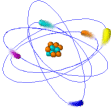Annual Review of Biomedical Engineering
Vol. 6: 427-452 (Volume publication date August 2004)
(doi:10.1146/annurev.bioeng.6.040803.140100)
First published online as a Review in Advance on April
13, 2004
FRACTAL ANALYSIS OF THE VASCULAR TREE
IN THE HUMAN RETINA
Barry R. Masters
Formerly, Gast Professor, Department of Ophthalmology, University
of Bern, 3010 Bern, Switzerland; email: brmail2001@yahoo.com
The retinal circulation of the normal human retinal vasculature
is statistically self-similar and fractal. Studies from several
groups present strong evidence that the fractal dimension of the
blood vessels in the normal human retina is approximately 1.7. This
is the same fractal dimension that is found for a diffusion-limited
growth process, and it may have implications for the embryological
development of the retinal vascular system.
The methods of determining the fractal dimension for branching
trees are reviewed together with proposed models for the optimal
formation (Murray Principle) of the branching vascular tree in the
human retina and the branching pattern of the human bronchial tree.
The limitations of fractal analysis of branching biological structures
are evaluated. Understanding the design principles of branching
vascular systems and the human bronchial tree may find applications
in tissue and organ engineering, i.e., bioartificial organs for
both liver and kidney.



